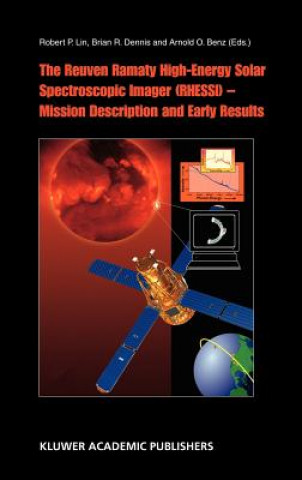
Livrare
Consilier de cumpărături





Nu se pretează? Nu contează! La noi puteți returna bunurile în 30 de zile
 Voucher cadou
orice valoare
Voucher cadou
orice valoare
Cu un voucher cadou nu veți da greș. În schimbul voucherului, destinatarul își poate alege orice din oferta noastră.
Reuven Ramaty High Energy Solar Spectroscopic Imager (RHESSI) - Mission Description and Early Results
 engleză
engleză
 488 b
488 b
30 de zile pentru retur bunuri
Ar putea de asemenea, să te intereseze


The Reuven Ramaty High Energy Solar Spectroscopic Imager (RHESSI) satellite was launched on 5 February 2002. Its objective is to study the energy release and particle acceleration in solar flares through observations of X-rays and gamma rays. Two novel technologies are combined to obtain both spectra and images over a broad energy range. For the spectroscopy, cooled hyperpure germanium detectors are used to cover the energy range from 3 keV to 17 MeV with unprecedented keV-class resolution. Since focusing optics are not possible for making images with such high energy photons, tungsten and molybdenum absorbing grids are used to modulate the X-rays and gamma-rays coming from the Sun as the spacecraft rotates. This allows the spatial Fourier components of the source to be determined so that images can be made in spectral ranges where astronomical images have never been produced before. These new instrumental techniques require equally innovative software to reconstruct X-ray and gamma-ray spectra and images from the observations. §Ample solar activity, abundant observations, and an open data policy have attracted many researchers. Astronomers face in the RHESSI mission an exciting new scientific potential. It has unusually broad possibilities for improving our understanding of the enigmatic solar flare phenomenon that is becoming increasingly important as society depends more and more on space-based technologies. §In this volume, the functioning of RHESSI is explained, the data analysis techniques including spectroscopy and image reconstruction are introduced, and the experiences of the first few months of operation are summarized. First scientific results are presented that provide the essential base for more extended studies using RHESSI data and complementary observations by instruments on other spacecraft and at ground-based solar observatories.Scientists and students will find here the latest discoveries in solar flare research, as well as inspiration for future work. The papers will serve as references for the many new discoveries to come from the continuing RHESSI observations.The Reuven Ramaty High Energy Solar Spectroscopic Imager (RHESSI) satellite was launched on 5 February 2002. Its objective is to study the energy release and particle acceleration in solar flares through observations of X-rays and gamma rays. Two novel technologies are combined to obtain both spectra and images over a broad energy range. For the spectroscopy, cooled hyperpure germanium detectors are used to cover the energy range from 3 keV to 17 MeV with unprecedented keV-class resolution. Since focusing optics are not possible for making images with such high energy photons, tungsten and molybdenum absorbing grids are used to modulate the X-rays and gamma-rays coming from the Sun as the spacecraft rotates. This allows the spatial Fourier components of the source to be determined so that images can be made in spectral ranges where astronomical images have never been produced before. These new instrumental techniques require equally innovative software to reconstruct X-ray and gamma-ray spectra and images from the observations.§Ample solar activity, abundant observations, and an open data policy have attracted many researchers. Astronomers face in the RHESSI mission an exciting new scientific potential. It has unusually broad possibilities for improving our understanding of the enigmatic solar flare phenomenon that is becoming increasingly important as society depends more and more on space-based technologies. §In this volume, the functioning of RHESSI is explained, the data analysis techniques including spectroscopy and image reconstruction are introduced, and the experiences of the first few months of operation are summarized. First scientific results are presented that provide the essential base for more extended studies using RHESSI data and complementary observations by instruments on other spacecraft and at ground-based solar observatories.Scientists and students will find here the latest discoveries in solar flare research, as well as inspiration for future work. The papers will serve as references for the many new discoveries to come from the continuing RHESSI observations.
Informații despre carte
 engleză
engleză




 Cum să cumpăr
Cum să cumpăr


























